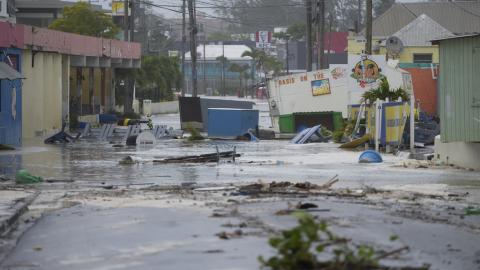
Beryl Makes Landfall as Category 4 Hurricane on Caribbean Island
SAN JUAN, Puerto Rico (AP) - A dangerous and extremely powerful Hurricane Beryl made landfall Monday on the Caribbean island of Carriacou after becoming the earliest storm of Category 4 strength to form in the Atlantic, fueled by record warm waters.
Winds up to 150 mph (240 kph), just shy of a Category 5 storm, blew off roofs, uprooted trees and caused other damage on Carriacou, one of the islands of Grenada, and elsewhere in the southeast Caribbean.
“This is an extremely dangerous and life-threatening situation,” the National Hurricane Center said.
Hurricane warnings were in effect for Barbados, Grenada, Tobago and St. Vincent and the Grenadines as thousands of people hunkered down in homes and shelters. The last strong hurricane to hit the southeast Caribbean was Hurricane Ivan 20 years ago, which killed dozens of people in Grenada.
NBC Radio in St. Vincent and the Grenadines said it received reports of roofs being torn off churches and schools as communications began collapsing across the southeast Caribbean.
In nearby Grenada, officials received “reports of devastation” from Carriacou and surrounding islands, said Terence Walters, Grenada’s national disaster coordinator. Prime Minister Dickon Mitchell said he would travel to Carriacou as soon as it’s safe, noting that there’s been an “extensive” storm surge.
Grenada officials had to evacuate patients to a lower floor after hospital roof was damaged, he said.
“There is the likelihood of even greater damage,” he told reporters. “We have no choice but to continue to pray.”
Later on Monday morning, Beryl was about 30 miles (50 kilometers) north of the island of Grenada, moving west-northwest at 20 mph (31 kph).
In Barbados, officials received more than a dozen reports of roof damage, fallen trees and downed electric posts across the island, said Kerry Hinds, emergency management director. Wilfred Abrahams, minister of home affairs and information, said drones - which are faster than crews fanning across the island - would assess damage once Beryl passes.
A tropical storm warning was in effect for St. Lucia, Martinique and Trinidad. A tropical storm watch was issued for Haiti’s entire southern coast, and from Punta Palenque in the Dominican Republic west to the border with Haiti. A hurricane watch was issued for Jamaica.
Forecasters warned of a life-threatening storm surge of up to 9 feet (3 meters) in areas where Beryl made landfall, with 3 to 6 inches (7.6 to 15 centimeters) of rain for Barbados and nearby islands and possibly 10 inches in some areas (25 centimeters), especially in Grenada and the Grenadines.
The storm was expected to weaken slightly over the Caribbean Sea on a path that would take it just south of Jamaica and later toward Mexico’s Yucatan Peninsula as a Category 1.
“Beryl is forecast to remain a significant hurricane during its entire trek across the Caribbean region,” the National Hurricane Center said.
Officials in some southeast Caribbean islands announced controlled power outages and warned of water cuts ahead of the storm, as well as landslides and flash floods. Schools, airports and government offices shuttered.
Beryl strengthened from a tropical depression to a major hurricane in just 42 hours - a feat accomplished only six other times in Atlantic hurricane history, and with Sept. 1 as the earliest date, according to hurricane expert Sam Lillo.
It also was the earliest Category 4 Atlantic hurricane on record, besting Hurricane Dennis, which became a Category 4 storm on July 8, 2005.
“This is a dangerous hurricane for the Windward Islands," said hurricane specialist and storm surge expert Michael Lowry. Beryl amassed its strength from record warm waters that are hotter now than they would be at the peak of hurricane season in September, he said.
Beryl is the second named storm in the Atlantic hurricane season, which runs from June 1 to Nov. 30. Earlier this month, Tropical Storm Alberto made landfall in northeast Mexico and killed four people.
The National Oceanic and Atmospheric Administration predicts the 2024 hurricane season is likely to be well above average, with between 17 and 25 named storms. The forecast calls for as many as 13 hurricanes and four major hurricanes.
An average Atlantic hurricane season produces 14 named storms, seven of them hurricanes and three major hurricanes.
Copyright 2024 The Associated Press. All rights reserved.



